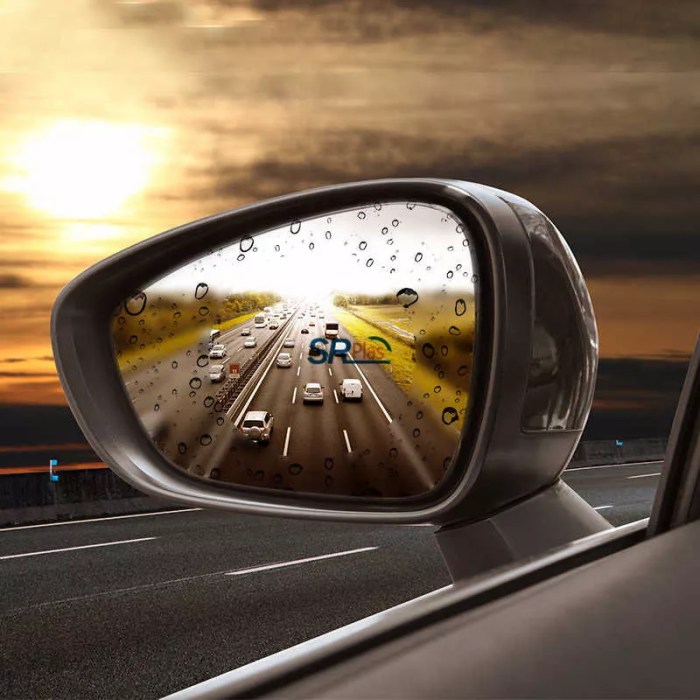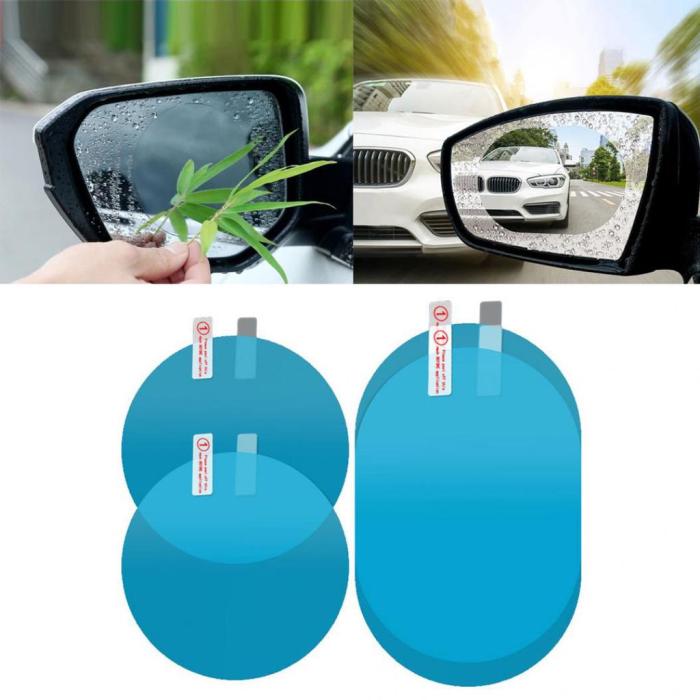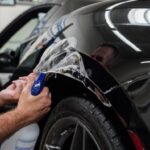Anti-fog solutions for car mirrors: Ever been driving in the rain, only to have your mirrors completely fog up? It’s a total buzzkill, right? This article dives deep into the science and solutions behind keeping those mirrors crystal clear, no matter the weather. We’ll explore everything from DIY hacks to high-tech heating elements, so you can find the perfect anti-fog solution for your ride.
We’ll cover different types of anti-fog solutions, comparing their effectiveness, cost, and longevity. We’ll also look at the chemistry behind anti-fog sprays, the physics of heating elements, and the engineering of ventilation systems. Plus, we’ll check out some cool futuristic anti-fog tech that’s on the horizon.
Types of Anti-Fog Solutions

So, you’re tired of blurry mirrors on those frosty mornings or rainy commutes? Dealing with fogged-up car mirrors is a common frustration, but thankfully, there are several technologies designed to combat this problem. Let’s dive into the different types of anti-fog solutions available for your car mirrors. These solutions range from simple DIY tricks to more advanced, integrated systems.
Chemical Coatings
Chemical coatings are a popular and relatively inexpensive way to prevent fogging. These coatings work by creating a hydrophobic (water-repelling) surface on the mirror. Water droplets bead up instead of forming a film, improving visibility. Many commercially available products utilize this technology, often applied as a spray or wipe-on solution. The effectiveness of these coatings varies depending on the specific product and the environmental conditions.
Some coatings may need reapplication after several weeks or months, while others claim longer-lasting protection.
Heating Elements
Electrically heated mirrors are a more sophisticated approach to anti-fogging. Thin resistive wires or conductive films are embedded within the mirror glass itself. When activated, these elements generate heat, preventing condensation from forming. Heated mirrors are generally very effective, providing clear visibility even in extreme conditions. However, they tend to be more expensive than chemical coatings and require an electrical connection, adding complexity to the vehicle’s system.
The energy consumption of these systems is also a consideration.
Ventilation Systems
Some vehicles incorporate ventilation systems designed to reduce fogging on the mirrors. These systems typically involve directing airflow over the mirror surface, preventing moisture from settling. While less direct than heating elements or chemical coatings, ventilation can still significantly reduce fogging, especially in conjunction with other methods. The effectiveness of ventilation systems depends heavily on the design and the airflow volume.
They are generally less effective in extremely cold or humid conditions.
Comparison Table
The following table summarizes the key characteristics of each anti-fog solution:
| Anti-Fog Solution | Effectiveness | Cost | Longevity |
|---|---|---|---|
| Chemical Coatings | Moderate; varies by product | Low | Short to moderate (weeks to months) |
| Heating Elements | High | High | Long (life of the mirror) |
| Ventilation Systems | Moderate; depends on system design | Moderate (integrated into vehicle design) | Long (life of the vehicle) |
Chemical Anti-Fog Treatments: Anti-fog Solutions For Car Mirrors

Chemical anti-fog solutions for car mirrors work by altering the surface tension of the mirror, preventing water droplets from forming and adhering. Instead of forming individual droplets that scatter light and create fog, water spreads into a thin, even layer, maintaining transparency. This is achieved through a variety of chemical compounds, each with its own application method and longevity.Many commercial anti-fog products utilize surfactants, which are amphiphilic molecules possessing both hydrophilic (water-loving) and hydrophobic (water-repelling) regions.
These surfactants reduce the surface tension of the mirror’s surface, allowing water to spread out evenly rather than beading up. Common surfactants include various types of alcohols, esters, and polymers. Some formulations also include other additives like cleaning agents to remove existing grime and improve adhesion of the anti-fog layer. The exact chemical composition varies widely between brands and types of product.
Chemical Composition of Anti-Fog Sprays and Coatings
Common anti-fog sprays often contain a mixture of surfactants, typically alcohols like ethanol or isopropanol, along with other solvents and potentially additives for fragrance or cleaning. Coatings, on the other hand, frequently involve more complex polymers that form a durable, long-lasting layer on the mirror surface. These polymers can be silicones, fluoropolymers, or other specialized materials designed for high durability and resistance to weathering.
For example, some high-end coatings utilize siloxane-based polymers, known for their water-repelling properties and resistance to UV degradation. The exact proportions and types of chemicals used are often proprietary information held by the manufacturers.
Mechanism of Fog Prevention, Anti-fog solutions for car mirrors
The primary mechanism behind chemical anti-fog treatments is the alteration of surface energy. Water molecules are attracted to each other (cohesion) and to the surface of the mirror (adhesion). If the adhesion is strong, water droplets form, scattering light and causing fog. Anti-fog solutions reduce the adhesion of water to the mirror surface by lowering the surface energy.
This encourages water to spread into a thin, transparent film rather than forming droplets. The surfactants in the solution effectively “weaken” the attraction between the water molecules and the mirror surface, promoting a uniform film. This principle is similar to how detergents work to clean dishes—they lower the surface tension of water, allowing it to better penetrate and lift away grease and dirt.
Application Methods and Durability
Anti-fog sprays are typically applied directly to the mirror surface using a spray bottle, then wiped clean with a microfiber cloth. Their effectiveness is usually temporary, lasting anywhere from a few hours to a few days, depending on weather conditions and the specific product. In contrast, anti-fog coatings are applied differently, often requiring a more thorough cleaning and preparation of the mirror surface.
These coatings might involve multiple applications or require a curing period for optimal performance. Coatings generally offer significantly longer durability, potentially lasting for several weeks, months, or even years, depending on the quality of the coating and environmental factors. For instance, a high-quality silicone-based coating may last for several months, while a cheaper alcohol-based spray might only last a single day.
Dealing with foggy car mirrors is a total drag, especially on those early morning commutes. But you know what else is annoying? Driving off-road at night without enough light, which is why checking out the latest tech like LED light bars for off-road trucks 2025 is a good idea. Anyway, back to those mirrors – a good defogger is a total game-changer for safer driving.
Heating Element Technology
Car mirror defogging systems using heating elements offer a direct and effective way to combat condensation. These systems work by raising the temperature of the mirror surface above the dew point, preventing water droplets from forming. Different technologies exist, each with its own advantages and drawbacks regarding energy efficiency, cost, and installation.
Several types of heating elements are employed in anti-fog car mirrors, each with varying characteristics in terms of power consumption and heat distribution. The choice of technology often depends on factors like cost, space constraints, and desired performance levels.
Resistive Wire Heaters
Resistive wire heaters are a relatively simple and established technology. They consist of thin, electrically conductive wires embedded within the mirror substrate or affixed to its backside. When an electric current passes through these wires, their resistance generates heat, warming the mirror surface. This method is generally robust and reliable, but it can be less energy-efficient than other options due to heat loss through the substrate.
Installation typically involves integrating the wires during the mirror manufacturing process, making it a less adaptable solution for retrofitting existing mirrors.
Thin-Film Heaters
Thin-film heaters offer a more advanced and space-saving alternative. These heaters are created by depositing a thin layer of resistive material, such as indium tin oxide (ITO), onto the mirror’s surface using techniques like sputtering or screen printing. This results in a nearly invisible heating element that’s directly integrated with the mirror’s reflective layer. Thin-film heaters are generally more energy-efficient than resistive wire heaters due to their close proximity to the mirror surface, minimizing heat loss.
However, the manufacturing process is more complex and potentially more expensive.
Carbon Nanotube Heaters
Carbon nanotubes, due to their exceptional electrical and thermal properties, are emerging as a promising material for anti-fog mirror heaters. These tiny tubes can be arranged to form a flexible and highly conductive heating element, potentially leading to even greater energy efficiency and improved heat distribution compared to traditional methods. However, the technology is still relatively new and may be more expensive to implement on a large scale.
Comparison of Heating Element Technologies
| Technology | Energy Efficiency | Installation Complexity | Cost |
|---|---|---|---|
| Resistive Wire Heaters | Moderate (relatively high power consumption) | High (usually integrated during manufacturing) | Low to Moderate |
| Thin-Film Heaters | High (lower power consumption) | High (complex manufacturing process) | Moderate to High |
| Carbon Nanotube Heaters | Very High (potential for lowest power consumption) | High (complex manufacturing process, emerging technology) | High |
Ventilation Systems for Defogging

Car mirror ventilation systems offer a proactive approach to fog prevention, working by actively managing the airflow around the mirror surface. Unlike reactive methods like chemical treatments or heating elements, ventilation aims to prevent condensation from forming in the first place by maintaining a consistent temperature and humidity level. This approach is particularly effective in environments with fluctuating temperatures and high humidity.Ventilation systems integrated into car mirrors typically involve strategically placed vents or channels that allow air to circulate across the mirror’s surface.
This airflow helps to dissipate heat and moisture, preventing the formation of water droplets that cause fog. The effectiveness of these systems depends heavily on the design and placement of these vents, the volume of air moved, and the overall design of the mirror assembly. Properly designed ventilation systems can significantly reduce or even eliminate fogging, improving driver visibility and safety.
Dealing with foggy car mirrors is a total drag, especially in the winter. Keeping your car clean is half the battle, but sometimes you need extra help. While you’re upgrading your car’s interior, why not check out these Affordable steering wheel covers for leather protection to keep things looking fresh? Back to those mirrors – a good anti-fog solution can really improve visibility and make those early morning commutes way less stressful.
Design Considerations for Effective Ventilation Systems
Several key factors influence the effectiveness of a car mirror ventilation system. Airflow volume and direction are crucial; a higher volume of air moving directly across the mirror surface is more effective at preventing fog. The size and placement of vents need careful consideration to ensure optimal airflow without compromising the mirror’s structural integrity or aerodynamic properties. The material used in the construction of the ventilation channels also impacts effectiveness, with materials that conduct heat well potentially enhancing performance.
Finally, integration with the car’s existing climate control system can allow for dynamic adjustment of airflow based on environmental conditions.
Examples of Ventilation System Designs and Their Effectiveness
Several different ventilation system designs exist, each with varying levels of effectiveness depending on the specific application and climate. One common design utilizes small, strategically placed vents around the perimeter of the mirror housing, directing air towards the mirror surface. This design is relatively simple and inexpensive to implement but may be less effective in extremely humid or cold conditions.
More sophisticated systems might incorporate a small fan within the mirror housing to actively circulate air, increasing the airflow volume and effectiveness. These active systems are generally more effective but are also more complex and expensive to manufacture. For example, a system using a miniature fan might be highly effective in a consistently humid tropical climate where passive ventilation alone might prove inadequate.
Conversely, a simple passive vent system might suffice in a drier climate with less drastic temperature fluctuations.
DIY Anti-Fog Solutions
So, you’re tired of battling foggy car mirrors? Commercial anti-fog products can be pricey, but luckily, there are several effective DIY solutions you can whip up using common household items. These methods offer a budget-friendly alternative, although their effectiveness might not always match that of store-bought options. Let’s explore how to make your own anti-fog concoctions and understand their strengths and weaknesses.
DIY Anti-Fog Solution Recipe
Creating a DIY anti-fog solution is surprisingly simple. The basic principle involves applying a thin, even layer of a substance that repels water, preventing condensation from forming on the mirror’s surface. The following steps Artikel a common and effective method:
- Gather your materials: You’ll need dish soap (a non-abrasive kind is best), white vinegar, and a spray bottle. A soft, lint-free cloth is also essential for application and cleaning.
- Mix the solution: In your spray bottle, combine equal parts dish soap and white vinegar. A ratio of 1:1 is a good starting point; you can adjust this based on your experience and the specific products you use.
- Clean the mirror: Before applying the solution, thoroughly clean your car mirrors with a clean, damp cloth. Remove any existing dirt, grime, or residue. This ensures the anti-fog solution adheres properly.
- Apply the solution: Lightly spray the mixture onto the mirror surface. Avoid over-spraying, as this can leave streaks and reduce effectiveness. Aim for a thin, even coating.
- Buff to a shine: Use your clean, lint-free cloth to gently buff the solution into the mirror’s surface. This helps distribute the solution evenly and removes any excess liquid.
Effectiveness and Limitations of DIY Solutions
DIY anti-fog solutions, while convenient and inexpensive, generally offer shorter-lasting protection compared to commercial products. Their effectiveness also depends heavily on factors such as the humidity and temperature of your environment. While they can significantly reduce fogging, they may not completely eliminate it under extremely humid or cold conditions. Commercial products often contain specialized surfactants and polymers designed for longer-lasting, more robust anti-fog protection.
Think of DIY solutions as a quick, temporary fix, while commercial products provide a more reliable, long-term solution. For example, a DIY solution might last for a couple of hours under moderate conditions, whereas a commercial product could easily last a whole day or even longer.
Future Trends in Anti-Fog Technology
The automotive industry is constantly striving for improved driver safety and comfort, and anti-fog technology is no exception. While current solutions are effective, ongoing research and development promise even more sophisticated and reliable methods for keeping car mirrors and windshields clear in challenging weather conditions. The future of anti-fog technology is likely to involve a blend of miniaturization, smarter materials, and enhanced integration with existing vehicle systems.The next generation of anti-fog solutions will likely focus on minimizing energy consumption, maximizing effectiveness, and seamlessly integrating with existing vehicle features.
This means moving beyond simple resistive heating elements to more efficient and adaptable technologies. Challenges include balancing cost-effectiveness with performance, ensuring durability and longevity, and designing solutions that are compatible with diverse vehicle designs and manufacturing processes.
Nanotechnology Applications
Nanotechnology offers promising avenues for developing highly effective and energy-efficient anti-fog coatings. Nanostructured surfaces can alter the surface tension of the glass, preventing water droplets from forming and adhering. These coatings can be incredibly thin, requiring minimal added weight or bulk to the vehicle, and their application could be easily integrated into existing manufacturing processes. For example, imagine a self-cleaning, anti-fog coating applied during the glass manufacturing process, eliminating the need for additional treatments or layers.
The challenges lie in scaling up nanomaterial production for mass automotive application and ensuring the long-term durability of these delicate coatings against harsh environmental conditions.
Smart Materials and Self-Regulating Systems
Future anti-fog systems could incorporate “smart” materials that respond dynamically to environmental conditions. These materials might change their properties based on temperature, humidity, or even the presence of water droplets, automatically activating anti-fog mechanisms only when needed. This approach could significantly reduce energy consumption compared to constantly active heating elements. For instance, a material that changes its surface characteristics from hydrophobic (water-repelling) to hydrophilic (water-attracting) depending on humidity levels could drastically reduce fogging by preventing water droplet formation.
The main challenge in this area is developing smart materials that are both cost-effective and reliable enough for mass automotive production.
Integrated Sensor Networks and Predictive Algorithms
Integrating advanced sensor networks and predictive algorithms into anti-fog systems represents a significant leap forward. Sensors could detect changes in humidity, temperature, and even the presence of fog or rain before condensation forms. This information would then be fed into an algorithm that preemptively activates the anti-fog mechanism, preventing fog from forming in the first place. This predictive approach, coupled with efficient anti-fog technologies, could offer a highly effective and energy-saving solution.
A real-world example could be a system that uses external weather sensors to anticipate fog formation and automatically activate a subtle heating element or a smart coating before the fog reaches the vehicle’s mirrors or windshield. The major hurdle lies in the complexity of such a system and the computational power required to process sensor data in real-time.
Potential Future Anti-Fog Solutions and Their Impact
The development of advanced anti-fog solutions is poised to significantly impact the automotive market. Here are some potential future solutions and their anticipated effects:
The following list highlights potential future anti-fog solutions and their projected impact on the automotive industry. These advancements could lead to increased driver safety, enhanced comfort, and a more sustainable automotive sector.
- Electrochromic glass: This technology allows the glass to change its transparency based on an applied voltage, reducing the need for separate anti-fog systems. Impact: Increased fuel efficiency due to reduced energy consumption for heating elements; improved aesthetic appeal.
- Plasma-based anti-fog systems: Plasma technology can ionize water molecules, preventing condensation. Impact: Highly effective anti-fogging with low energy consumption; potential for integration with other vehicle systems.
- Aerodynamic design improvements: Optimized airflow around mirrors and windshields could reduce the accumulation of moisture. Impact: Reduced reliance on active anti-fog systems; improved fuel efficiency.
- Self-healing coatings: Coatings that automatically repair minor scratches and damage, maintaining their anti-fog properties over the vehicle’s lifespan. Impact: Increased durability and longevity of anti-fog solutions; reduced maintenance costs.
Illustrative Examples of Anti-Fog Mirror Designs
Auto manufacturers employ various strategies to combat fogging on car mirrors, impacting driver safety and visibility. Three distinct designs exemplify the range of anti-fog technologies currently available. These examples highlight the trade-offs between effectiveness, durability, and cost in mirror design.
Electrochromic Mirror Design
Electrochromic mirrors utilize a thin layer of electrochromic material sandwiched between two conductive layers of glass. This material changes its optical properties (transparency) in response to an applied voltage. When fog forms, a small electrical current is applied, causing the electrochromic layer to become transparent, effectively clearing the mirror. The construction is sophisticated, involving precise layering of materials for optimal performance.
The glass is typically durable, resistant to scratching and shattering. However, the manufacturing process is complex and requires specialized equipment, resulting in higher production costs. The effectiveness is excellent, providing a clear view even in highly humid conditions. Durability is also high, with the electrochromic layer designed to withstand years of use. The primary weakness is the higher initial cost compared to simpler solutions.
Heated Mirror Design
Heated mirrors incorporate thin resistive heating elements embedded within the mirror’s glass substrate. These elements are usually made of conductive metallic oxides or thin metal wires. When activated, they generate heat, preventing moisture from condensing on the mirror’s surface. The construction involves integrating the heating element during the glass manufacturing process, making it a robust and integrated design.
Materials used are typically durable glass and corrosion-resistant heating elements. Heated mirrors offer good effectiveness, quickly clearing fog in most conditions. Durability is generally high, although prolonged exposure to extreme temperatures might affect the heating element’s lifespan. The cost is relatively moderate, falling between the less expensive chemical treatments and the more expensive electrochromic systems. A potential weakness is the energy consumption associated with heating, which could slightly impact fuel efficiency.
Ventilated Mirror Design
Ventilated mirrors utilize a small fan or air blower to circulate air across the mirror’s surface. The design involves incorporating a small, low-power fan within the mirror housing. This fan draws in ambient air and directs it across the mirror, preventing condensation. The construction is relatively simple, involving standard mirror materials and a compact fan assembly. Effectiveness is dependent on the fan’s power and the ambient air conditions.
In very humid environments, its effectiveness might be limited. Durability is typically good, with the main concern being the potential for fan failure over time. The cost is generally low, making it a cost-effective solution. However, the effectiveness is less reliable than heated or electrochromic systems, particularly in extreme conditions.
Ending Remarks
From simple DIY solutions to cutting-edge technology, there’s a way to banish mirror fog for good. Whether you’re a car enthusiast, a DIY whiz, or just someone who hates blurry mirrors, this guide has you covered. So ditch the foggy mirrors and hit the road with confidence – your clear vision awaits!









